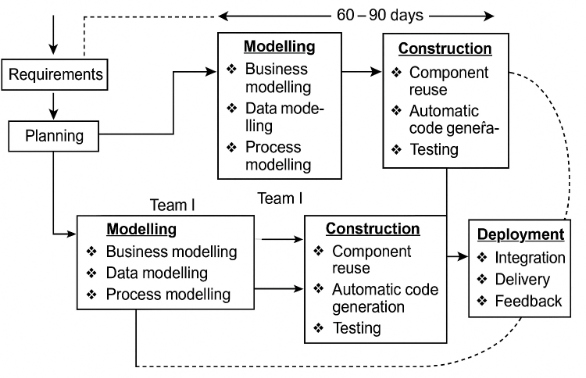- Introduction to Software Engineering
- The Evolving Role Of Software
- Changing Nature Of Software
- Software Myths
- A Generic View of Process
- Software Engineering- A Layered Technology
- A Process Framework
- The capability maturity model integration (CMMI)
- Process Patterns
- Process Assessment
- Personal And Team Process Models
- Process Models
- The Waterfall Model
- Incremental Process Models
- Evolutionary Process Models
- The Unified Process Model
Incremental model and RAD process
Incremental model
The incremental model is a software development approach where the system is designed, implemented, and tested incrementally (in small portions or “increments”). This model allows the system to be developed in parts, with each increment adding more functionality over time. It’s commonly used in situations where requirements are expected to evolve or when the development process needs to be flexible.
When we use the incremental model?
When the requirements are superior.
A project has a lengthy development schedule.
When software team are not very well skilled or trained.
When the customer demands a quick release of the product.
You can develop prioritized requirements first.
Advantage of incremental model
Errors are easy to be recognized.
Easier to test and debug
More flexible.
Simple to manage risk because it handled during its iteration.
The client gets important functionality early.
Disadvantage of incremental model
Need for good planning
Total cost is high.
Well defined module interfaces are needed.
RAD process
The RAD model or Rapid Application Development model is a type of software development methodology that emphasizes quick and iterative release cycles, primarily focusing on delivering working software in shorter timelines. Unlike traditional models such as the Waterfall model, RAD is designed to be more flexible and responsive to user feedback and changing requirements throughout the development process.
When to use the RAD model?
Well-understood requirements: When project requirements are stable and transparent, RAD is appropriate.
Time-sensitive projects: Suitable for projects that need to be developed and delivered quickly due to tight deadlines.
Small to medium-sized projects: Better suited for smaller initiatives requiring a controllable number of team members.
High user involvement: Fits where ongoing input and interaction from users are essential.
Innovation and creativity: Helpful for tasks requiring creative inquiry and innovation.
Prototyping: It is necessary when developing and improving prototypes is a key component of the development process.
Low technological complexity: Suitable for tasks using comparatively straightforward technological specifications.
Advantages of Rapid Application Development model (RAD)
The use of reusable components helps to reduce the cycle time of the project.
Feedback from the customer is available at the initial stages.
Reduced costs as fewer developers are required.
The use of powerful development tools results in better quality products in comparatively shorter periods.
The progress and development of the project can be measured through the various stages.
Disadvantages of Rapid Application Development model (RAD)
The use of powerful and efficient tools requires highly skilled professionals.
The absence of reusable components can lead to the failure of the project.
The team leader must work closely with the developers and customers to close the project on time.
The systems which cannot be modularized suitably cannot use this model.
Customer involvement is required throughout the life cycle.
